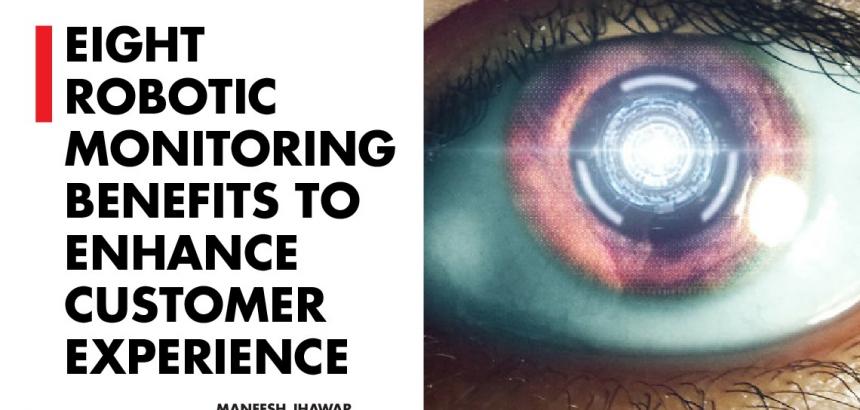Robotic monitoring and artificial intelligence (AI) are widely used for physical surveillance of security and defence areas, factories, and residential premises. As robots can monitor a given area tirelessly and with precision, they make the task of surveillance reliable.
Powered by the capabilities of precision, tirelessness, and reliability, robotic monitoring is being used by many forward looking organisations to deliver speckless customer experience across their digital properties. Let’s examine this with a few cross-industry examples.
1. VIGILANT, 24×7 MONITORING
Robotic monitoring can help companies deliver a dainty user experience. Take an example from the banking world. Created and defined as a (robotic) customer, a bot can be programmed to check each and every user journey across a bank’s net-banking and mobile banking channels every few minutes.
While the bank’s support staff can probably check its systems for a few times in a day—or worse, after a support ticket is opened, a bot can diligently check every customer journey round-the-clock. As a result, IT support can be informed of technical issues (availability/performance of individual pages) immediately for speedy troubleshooting.
2. GOING BEYOND THE SILOS
When support teams track systems looking for potential issues, those checks are generally performed on individual systems such as applications, servers, network, etc., in silos. However, a customer journey, such as buying a holiday package on a travel website, cuts across all these.
Unless the tracking process exactly replicates the activities a customer performs, the customer journey(s) cannot be truly monitored. A bot, mimics a real customer, can track and check the entire customer journey, thus, connecting all silos with actionable insights.
3. OPTIMAL UTILIZATION OF LEAN HOURS
The data-center support staff of an insurance company usually carries out important backend functions such as daily backups, maintenance, hardware and/ or software upgrades during the lean hours of midnight when traffic is at its lowest. Performing these tasks during midnight ensures their potential adverse impact on customer experience is minimal. Moreover, it’s difficult for support staff to quickly identify technical issues that maintenance activities may newly introduce.
As bots can be commissioned and decommissioned at will, insurance carriers can deploy multiple bots during and after their nightly maintenance to instantaneously spot and fix errors before they affect customers.
4. HIGH ACCURACY AND RELIABILITY
Remember the old, Windows-based Mine Sweeper game? You check each and every tile to identify the one(s) that may have mines under them. A similar task can be assigned to a bot to thoroughly scan the entire customer journey looking for potential ‘mines’ i.e. errors. While the game requires a player to identify mines by not clicking on them, a bot, on the other hand, mimics every possible step a customer may take in each and every journey.
Bots, with their diligence and meticulousness, help ensure a near 100 percent accuracy in detecting errors and issuing alerts. Given their high accuracy level, when a contact center does not receive alerts for a long time, it can be safely assumed to mean that there are no issues with the organisation’s systems.
5. PREDICTIVE MAINTENANCE
Due to their machine learning (ML) capabilities, bots, while monitoring customer journeys over a long period of time, tend to develop an understanding of symptoms that potentially lead to technical issues. As this understanding evolves, bots can help organisations precisely detect issues even before they occur and alert the support staff to take preventive action.
6. SLA CHECKS
Services delivered by an e-commerce company are made possible due to pre-existence of a highly complex ecosystem of technology stacks and services provided by multiple vendors at the backend. As a bot scours each and every potential activity of a buyer, it may spot when and whether services offered by third party vendor(s) meet necessary standards or not. This way, bots can help organisations enforce service-level agreements (SLAs) they sign with multiple third-party agencies.
7. ENSURING SECURITY
As bots quietly check each point of a customer journey, they unearth every discrepancy possible. For instance, to check a customer journey, bots can check and validate smooth functioning of security features like Captcha or one-time password (OTP). Moreover, as bots scrutinize an organisation’s website by comparing its byte size every few minutes, it can instantly catch malicious acts such as homepage defacement of a corporate website.
8. CAPACITY PLANNING
The machine learning (ML) capabilities of bots along with their round-the-clock monitoring can help an organisation’s datacenter administrators understand system utilisation patterns better. These insights, in turn, can help them scale up or scale down the capacity (in case of a cloud model), thus, ensuring sustained business continuity while achieving cost optimisation at the same time.
Suggested reading: Top emerging technology trends that will bridge the gap between humans and technology
Robotic monitoring, thus, improves quality of customer experience while delivering advantages of speed and accuracy. For instance, all leading organisations (across sectors) engage with their target customers via mobile apps, online and social media channels. Robotic monitoring can help them ensure that customer experience is not compromised even for a minute.
GUEST AUTHOR:
Maneesh Jhawar, Founder & CEO, QualityKiosk
Maneesh started QualityKiosk Technologies in the year 2000, after sensing the need-gap in the software testing industry. His constant emphasis and personal commitment towards governance, best-in-class business practices and constant innovation is the foundation that has helped QualityKiosk establish superior credentials with clients consistently. In his career of 26 years, his customer-centric attitude is based on the philosophy of treating customer’s business challenges as his own which inspires each of his employees to work towards business outcomes for clients.
Maneesh started his career with Procter and Gamble in 1990 where his achievements included setting up of a Toothpaste Manufacturing Facility for Exports in record time. Always obsessed with Quality he set up the TQM (Total Quality Management) practice at P&G’s flagship manufacturing facility. He then founded his business Maneesh Pipes Private Limited, an EPC company for large water supply schemes and piping solutions for all industries. He is also an investor and on the Advisory Board of three companies in Mobility, Data Analytics and e-Commerce space.
A B.Tech from IIT Kanpur, Maneesh has also completed a program on “Transforming Professional Services Companies” from Harvard Business School. Maneesh enjoys reading books and has a collection of 1000+ classics. He is the President of MPM Trust which runs one of the largest community centres in Navi Mumbai.
First published at: Wire19.com/



